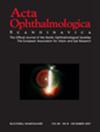Is there a predisposition for developing corneal hydrops in keratoconus?—Tomographic and biomechanical analysis of the fellow eyes
Abstract
Aim
Fellow eyes (FE) of 73 keratoconus (KC) patients with acute corneal hydrops (ACH) and 130 KC patients without ACH (total 236 eyes, 110 more severely affected), serving as control groups, were retrospectively analysed to identify potential risk factors associated with the development of ACH.
Methods
Tomographic (Pentacam®) and biomechanical analysis (Corvis ST®, both Oculus, Germany) were performed. Tomographic parameters are as follows: K-max, thinnest corneal thickness (TCT), Belin/Ambrósio deviation (BAD-D) and the tomographic ABCDE-staging. Biomechanical analysis included Integrated Radius (IR), DA Ratio (1 and 2 mm), stiffness parameter A1 (SP-A1), Ambrósio's relational thickness horizontal (ARTh), Corvis Biomechanical Index (CBI), Corvis Biomechanical Factor (CBiF) and the biomechanical E-staging.
Results
Among ACH patients, most were males (77%), with pre-existing conditions including allergies (36%), asthma (10%) and frequent eye rubbing (61%), with no significant differences to the control group (CG). The ABCDE staging showed significantly different distribution patterns, with the ACH-FE predominantly showing stage B4, contrasting with a more heterogeneous distribution in both control groups. ACH-FE showed significantly lower SP-A1 levels than the CG (71 vs. 80 for CG all eyes, p < 0.001 and 71 vs. 76 for more severely affected control eyes, p = 0.01; Mann–Whitney U test).
Conclusions
ACH-FE showed a predominant presence in stage B4, yet a heterogenic distribution in the other tomographic parameters (‘A’|‘C’). Lower SP-A1 values suggest that these eyes may be less stiff and resistant to mechanical stress. Our results potentially indicate a histopathological weakness in the posterior cornea that could predispose one to the development of ACH.

 求助内容:
求助内容: 应助结果提醒方式:
应助结果提醒方式:


